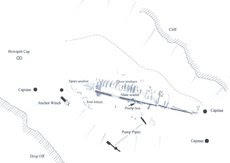Day 3 draws to a close, and the 3 newest holders of the NAS Part 1 Certificate in Foreshore and Underwater Archaeology are feeling rather pleased. It's been a long day, with a lot of new information to take in, but the sense of achievement is well-deserved.
Following on from our previous classroom and underwater work we moved onto a 3D mapping task just off a local beach.
 Jordyan setting up a control point near the target - a small plastic boat.
Jordyan setting up a control point near the target - a small plastic boat.
We spent the morning collecting our data, and later we'll enter the data into a computer program which will produce a 3D diagram of the site and any points of interest.
In the afternoon it was back into the classroom for a case study of an archaeology project from start to finish, which helped put everything into perspective whilst highlighting the eternal debate about the ethical factors in securing funding for archaeological projects.
We all jumped at the chance to dive one of the wrecks in the Sound of Mull during the afternoon. The Shuna lies upright in 30m of water, and we tried identifying the layout and some points of interest, whilst enjoying a slightly deeper dive than the beach at 2m!
Througout the day the 3 initial participants were joined by the remaining 4 divers for the duration of the fieldschool, which takes place over the next 10 days, watch this space for more updates!
After dinner we were treated to an excellent talk on the 'Duart Point Wreck' by Colin Martin, who has spent numerous years surveying and investigating the site. Sunk in 1653 and believed to be the wreck of the Swan, its identity has still not been conclusively established. Maybe, as newly qualified NAS Part 1 individuals, we may one day be able to play some role in this fascinating story! The 'archaeolological lasagne' in the title was Colin's way of describing layers of ship decks and sediment!
Tomorrow we will get to dive the wreck and visit Duart Castle, and learn more about the sequence of events which leads us back to the modern day. Keep reading this blog to see what we get up to tomorrow!
 Jordyan setting up a control point near the target - a small plastic boat.
Jordyan setting up a control point near the target - a small plastic boat.We spent the morning collecting our data, and later we'll enter the data into a computer program which will produce a 3D diagram of the site and any points of interest.
In the afternoon it was back into the classroom for a case study of an archaeology project from start to finish, which helped put everything into perspective whilst highlighting the eternal debate about the ethical factors in securing funding for archaeological projects.
We all jumped at the chance to dive one of the wrecks in the Sound of Mull during the afternoon. The Shuna lies upright in 30m of water, and we tried identifying the layout and some points of interest, whilst enjoying a slightly deeper dive than the beach at 2m!
Througout the day the 3 initial participants were joined by the remaining 4 divers for the duration of the fieldschool, which takes place over the next 10 days, watch this space for more updates!
After dinner we were treated to an excellent talk on the 'Duart Point Wreck' by Colin Martin, who has spent numerous years surveying and investigating the site. Sunk in 1653 and believed to be the wreck of the Swan, its identity has still not been conclusively established. Maybe, as newly qualified NAS Part 1 individuals, we may one day be able to play some role in this fascinating story! The 'archaeolological lasagne' in the title was Colin's way of describing layers of ship decks and sediment!
Tomorrow we will get to dive the wreck and visit Duart Castle, and learn more about the sequence of events which leads us back to the modern day. Keep reading this blog to see what we get up to tomorrow!

I would like to use this picture in my master thesis, to illustrate volunteers to archaeology. Full references to this site will be made. Please respond to siljecs(a)stud.ntnu.no asap if you have objections.
ReplyDeletebest, Silje